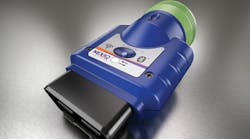Severe weather conditions are demanding on vehicles and fleet operations. This is why fleets take extra precautions before cold, snowy winter weather blows in. But it should be a focus prior to the dry, hot summer months as well.
“We look at summer similar to how a lot of people look at winter,” explains John Crichton, director of field support, Navistar (www.navistar.com), a manufacturer of commercial trucks, buses, defense vehicles and engines. “Any time you have extreme temperatures – whether you’re talking about extreme cold or extreme heat – that taxes the vehicle and specific systems.”
“Maximum vehicle uptime is essential to profitable operation,” adds Brian Tabel, executive director of marketing, Isuzu Commercial Truck of America (www.isuzucv.com), the distributor of Isuzu commercial trucks in the United States. “Key to this goal is preventive maintenance (PM).”
Tabel emphasizes the importance of PM intervals, especially prior to summer months. “Severe vocational operations added to extreme operation environments will require an increase in frequency of maintenance procedures,” he says.
The focus of summer maintenance should revolve around the vehicle’s coolant system, Crichton explains. He says when ambient temperature starts to climb, and systems aren’t operating correctly, it leads to engine overheats, de-rates and warning light trips.
He recommends inspecting the following areas before summer temperatures rise:
- Cooling system, inspecting the air flow through the radiator and whether fans are turning on and off correctly.
- A/C system, ensuring the system is properly charged and the operator will be comfortable in extreme temperatures.
- Tires, most notably air pressure.
- Alternator, checking to make sure the cooling fins are clean and free of de-icing chemicals used during winter months.
“Those four items are typically areas that can drive high expense if you don’t take care of them up front,” advises Crichton. “Those are also four areas that are relatively simple to take care of if you have the vehicle in for a PM.”
Furthermore, Tabel suggests inspecting:
- Belts for cracks and tension.
- Coolant hoses.
- The temperature the fan clutch engages.
- Water pump.
- Cabin vent filter.
- Air duct temperature with the A/C running.
- HVAC, heater and air directional controls.
ENGINE
The engine potentially can be the biggest expense for fleets if there is a failure, so Navistar’s Crichton advises fleets inspect the cooling system package first.
“In most cases, you don’t really need to do a lot to the engine, itself,” he says, adding that cooling fan on the front of the engine needs to be operating correctly. “But as far as going in internally, or doing anything specific for the engine, that’s really not necessary. Most of the companies now use an oil that’s pretty good whether you’re talking about cold or hot (temperatures).”
Also, make sure transmissions have a clean cooler so that good airflow can be achieved. The fluid in the transmission remains the same regardless of seasonal operations.
SEASONAL PM
Much of what is required for summer brake maintenance is addressed during regular PM intervals, Crichton of Navistar advises.
“The system itself is pretty low maintenance if you keep the condensation drained out of your air tanks – either through an automatic valve or a manual valve,” he says, adding air dryers that automatically keep the system dry sometime require filters to be changed out. “Whether it’s winter or summer, there’s not a lot of difference when it comes to the brake system’s maintenance.”
To avoid a catastrophic failure, downtime and the expenses occurred from having a vehicle out of operation, fleets should make seasonal preventive maintenance a priority among its technicians.
“For the fleets that have their own technicians, meet with them and make sure they understand what systems they ought to look at a little closer this time of year,” Crichton suggests, noting small things like cabin air filters for A/C systems can be overlooked.
“Maintenance is critical to achieve the lowest cost of ownership,” agrees Tabel of Isuzu. “Seasonal maintenance and vehicle checks are as important as scheduled mileage maintenance.”
RADIATORS
Hotter temperatures cause radiators to work overtime, explains Randy Pruitt, CEO, Detroit Radiator Corporation. This, in turn, leads to fans turning on sooner and running longer to keep the unit’s temperatures in the “safe zone.”
“If your cooling system has not been maintained properly, there is a higher chance that you will overheat your engine and cause major damage,” he says.
Detroit Radiator Corporation (www.detroitradiatorcorp.com) is a manufacturer, re-manufacturer and distributor of aftermarket cooling product solutions serving the heavy duty transportation, commercial, industrial and agricultural industries.
When a radiator is not functioning properly, Pruitt says several issues can arise. These include:
- Head gasket failure.
- Cylinder head failure.
- Warped cylinders.
- Engine block failure.
- Loss of fuel mileage.
- Loss of horsepower.
The head gasket, itself, is a relatively inexpensive part to replace. However, Pruitt warns it is a labor-intensive job that can take hours to complete.
“The more serious failures, such as the warped cylinders and engine block failure, would require you to repair and/or replace all internal components of your engine, or possibly the entire engine itself would have to be swapped out if the damage reaches catastrophic levels.”
To avoid these problems all together, Pruitt encourages several preventive measures. First, he suggests inspecting the vehicle’s charge air cooler, A/C condenser and radiator for any debris that may obstruct air flow.
Additionally, check for any cooling fins on the radiator that could be corroded or possibly folded over.
“When fins are folded over, they can restrict airflow,” Pruitt says. “If your fins are corroded, they do not have the ability to dissipate the heat from the coolant running through the internal tubes of the radiator.”
Lastly, he recommends fleets test the coolant regularly for appropriate additive levels and only use a coolant that meets industry standards and performance requirements.
“The best advice to avoid any radiator-related issues is to follow proper maintenance protocols,” he adds. “Inspect all hoses and clamps to ensure they’re not deteriorating or potentially collapsing on themselves.”
BATTERIES
Extreme heat can be a hardship for batteries, no matter if a vehicle utilizes a flooded or AGM battery, explains Brad Bisaillon, director of strategic accounts and transportation sales, Trojan Battery (www.trojanbattery.com), a manufacturer of deep-cycle vehicle batteries.
“Heat can be a challenge – especially extreme heat – and there are some battery box designs that are not necessarily friendly from a temperature perspective,” he says. “They generate and trap heat. Excessive heat can cause batteries to gas and fail prematurely.”
When a battery is not functioning correctly, it leads to a degradation of the plates, internally, and there is a loss of capacity. But Bisaillon says the biggest issue is the truck is no longer in operation for the fleet.
“They lose the ability to start and crank the engine, leading to that ultimate no-start, which is going to contribute to downtime,” he says.
If a battery cannot start a vehicle, it typically requires a service call for a jump start and then a trip to the shop to be checked. Once at the shop, there is little that can be done to repair a battery, so a replacement needs to be purchased.
In some cases, other components may need to be replaced if the cause of the dead battery is not the battery itself, notes Bisaillon.
When it comes to heat, there are not many preventive maintenance measures that can be taken. Because a battery’s ability to handle heat is often inherent to the truck design and battery box design, he says researching and selecting an appropriate battery at the time of purchase can help alleviate the risk of failure and downtime due to excessive heat.
“No battery is immune to the effects of high heat. Some will tolerate it longer than others,” Bisaillon says, noting that both flooded and AGM batteries will gas more frequently in higher temperatures, which accelerates the end of the battery’s life.
What’s more, it is important to check terminals – not only at the battery, but also at the alternator and starter. Bisaillon also suggests observing the condition of the cables, which should be done at every PM interval, regardless of season.
TIRES
As summer approaches, it is important for fleets and to remember ambient temperatures have an effect on truck tire inflation levels, says Brian Buckham, general manager, product marketing, Goodyear.
“In the wintertime, we advise fleets that inflation pressure can drop 1 lb for every 10-degree decrease in ambient temperature,” he explains. “Conversely, tire inflation pressure levels can increase when ambient temperatures are high. That’s why it’s important to check tire inflation pressure levels at least once a week, using a calibrated tire gauge – and more often, if possible.”
Goodyear Tire and Rubber Company (www.goodyear.com) manufactures commercial truck tires and offers related services among other automotive tire-related products.
Truck drivers who travel across various geographical landscapes and different climates should pay extra attention to inflation levels.
“Imagine driving through the Arizona desert on a Monday, then driving up into the Colorado Rockies a day or two later; there will be ambient temperature fluctuations,” Buckham explains. “In situations like this, even more frequent pressure level checks are recommended.”
While there is no substitute for maintaining correct tire inflation levels, he adds some tires contain special compounds to help tires run cooler. This can benefit operation, especially when confronted with high road-surface and ambient temperatures.
“Running a tire at less-than-optimal inflation generates heat, and heat can shorten a tire’s life,” he says. “Quite simply, maintaining correct inflation pressure is the single most important thing a fleet can do to protect a tire’s structural integrity and performance as it relates to temperature.”
He says this is also important if a fleet wants to extend the life cycle of its casings through retreading.
What’s more, maintaining correct inflation levels benefits fleets by:
- Positively impacting tire wear.
- Preventing the vehicle’s engine from working harder.
- Reducing the amount of fuel that a vehicle uses.
INCREASE UPTIME
Again, fleets should make preparations for anticipated hot weather conditions prior to summer beginning.
“Any time you take the heat up into triple-digit numbers, any weakness you have in certain vehicle systems is usually going to result in an increased downtime, unplanned service event,” warns Navistar’s Crichton.
Using A/C systems as an example, Crichton explains a couple hours of labor and few replacement parts during a scheduled PM event may cost $200 or $300. However, if the system is not maintained and the A/C compressor fails and contaminates the entire system, that catastrophic failure – coupled with downtime – could cost as much as $1,500 or $2,000 to rectify.
“As an OE and as truck owners, everyone is trying to reduce unscheduled repair visits,” he adds. “It helps their profitability. It certainly helps their driver retention. So there’s a lot of reasons to look at it differently than we have in the past.”





